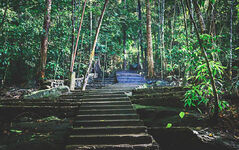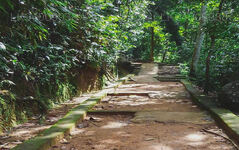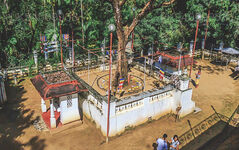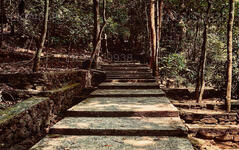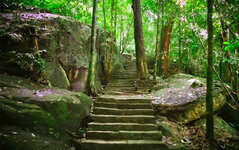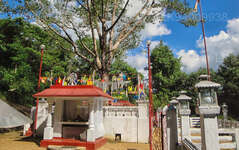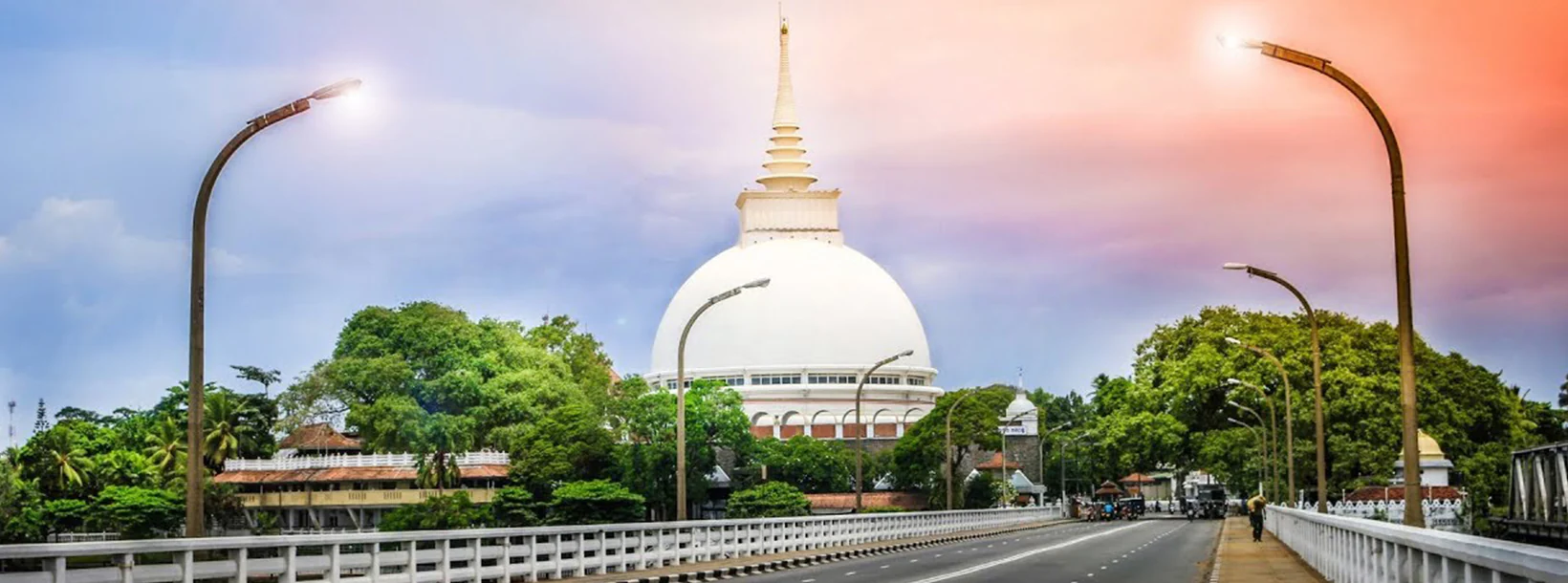
Kalutara City
Kalutara is a coastal city in western Sri Lanka, known for its serene beaches and historic sites. The iconic Kalutara Bodhiya, a sacred Buddhist stupa, and the Richmond Castle, a colonial mansion, are prominent attractions. The city blends cultural richness with natural beauty.
Bodhinagala Forest Hermitage
Bodhinagala Forest Hermitage in Sri Lanka: A Place of Serenity
The hermitage in Dombagaskanda also known as the Bodhinagala Forest Hermitage in Sri Lanka, nestling on the bank of the Kalu Ganga near the Dombagaskanda hill in the outskirts of Ingiriya in the Kalutara district, lies beneath the leafy canopy of a wet zone rain forest reservation of some 347 hectares. The natural rain forest shields the hermitage from the hustle and bustle of the outside world, providing a serene environment for the meditating monks.
To reach the Bodhinagala forest hermitage, one has to travel on the Panadura-Ratnapura (A-8) highway and travel 1.5 km along the minor road which leads to the Kalu Ganga. Before coming to the river, the road branches off to the left and continues for another 1.1 km, and comes to an area where it reaches the foot of Dombagaskanda. Although the road up the hill is accessible by vehicle, it’s better to get off one’s vehicle at this point and walk through the forest.
Positioned at the heart of the forest is a hermitage which has been there from way back in time, from the early 1950s. This is the closest tropical rain forest that can be reached from the main city of Colombo. The Bodhinagala Forest is conserved for this very reason and was once 407 hectares of pristine jungle.
An amazing patch of wilderness complete with gentle slopes, crafting ridges and peaks, with the highest peak rising to 186 meters above mean sea level, the forest reserve is bordered by the Kalu river from the south, Ingiriya Ela from the east, paddy fields from the north and the road leading from the main road to the Bodhinagala Monastery from the west.
Bodhinagala Forest Hermitage in Sri Lanka: The surrounding Wildlife
Just walking down the main trail gives any visitor an idea of the rich biodiversity that’s trapped in this heaven. An endemic Grey Hornbill or two greeting you at the entrance is but a common encounter here. From the familiar high pitched whistle of the Hill Mynahs, and the Rose Ringed Parakeets, to the chirpy
chit chats of the colorful little Hanging Parakeet, to an endless chirping of the crickets, with the company of a leech or two, all become part of an experience in the tropical jungles of Sri Lanka. Activities of the vibrant plumed Black Naped Monarch, Tickles Blue Flycatchers, and the flocks of Scaly
Breasted Munias keep the forest alive.
Other birds that could be heard included Yellow-browed Bulbul, Green Imperial-pigeon, Oriental Dwarf Kingfisher, etc. Both the endemic Toque and Purple-faced Leaf Monkeys could also be seen.
Bodhinagala Forest Hermitage in Sri Lanka: The History
The history of the Bodhinagala Forest Hermitage in Sri Lanka goes back to the early 1950s. Ven. Olaboduwe Sri Revatha Dhamma Kitti Thera, the principal of the Dharmadeepa Vipassana Piriwana in Kaluwamodara in Aluthgama was the founder of the hermitage. He came to Ingiriya to observe Vas on
the invitation of devotees in the Raigam Korale.
He stayed in a makeshift hut at a cemetery close to the Ingiriya hospital with seven bhikkhus. More people thronged Ingiriya to listen to the Dhamma Desana and meditation practices conducted by the Ven. Thera. After the Vas season was over, the bhikkhus prepared to go back, but the devotees persuaded them to stay permanently.
Ven. Olaboduwe Sri Revatha Thera, with the help of a few villagers, visited the thick forest of Dombagaskanda and at first, sight realized it was ideal for a forest hermitage. The villagers and devotees in the Raigam Korale have constructed the Kurtis and other buildings in the Dombagaskanda forest and on June 4, 1955, the complete hermitage of Bodhinagala was offered to the Sangha.
In the beginning, 12 bhikkhus lived in the small Kuti in five acres of forest. Later, it was expanded to 50 acres during the time of the late M.D.H. Jayawardena, the then MP for Horana. Today, this hermitage has numerous constructions including Kuti, meditative pathways, and medical halls, linked together and developed as a reputed forest hermitage in the country.
Bodhinagala Forest Hermitage in Sri Lanka: Features of the Hermitage
An interesting feature about the monastery is the Gaudiya, the short tree trunk is used as a bell. When beaten with a stick, it emanates a large sound. It’s hung on a tree and is sounded around 10.00 am every day to call the monks of the hermitage to the main Dana Salawa from where they go on Pindapatha.
While about 12 bhikkhus permanently reside at the hermitages, foreign bhikkhus also come for short periods to practice meditation. They live and meditate in the small Kuti in the hermitage, having left all their wealth and loved ones. To avoid disturbing the bhikkhus, visitors are allowed into the area of the
Kuti only from 12 noon to 1.00 pm.
Under the guidance of the Viharadhipathi, the Bodhinagala Forest Hermitage Trust has undertaken the construction of a Chaitya to fill a long-standing need. Construction has already begun with the assistance of devotees and philanthropists. The project is estimated to cost Rs. 8.5 million.
About Kalutara District
Kalutara is situated approximately 42km south of Colombo. Once a spice trading post, Kalutara was controlled variously by the Portuguese, Dutch and British. The town is famous for quality bamboo basket and mats and the most luscious mangosteens.
The 38-meter long Kalutara Bridge was built at the mouth of the Kalu Ganga River and serves as a major link between the country's Western and Southern border. At the southern end of the bridge lies the 3 stories-high Kalutara Vihara, a Buddhist temple built in the 1960s which holds the distinction of being the only stupa in the world that is hollow.
About Western Province
The Western Province is the most densely populated province of Sri Lanka. It is home to the legislative capital Sri Jayawardenapura as well to Colombo, the nation's administrative and business center. Western Province is divided into 3 main districts called Colombo (642 km²), Gampaha (1,386.6 km²) and Kalutara (1,606 km²) districts. As Sri Lanka's economic hub, all the major local and international corporations have their presence in the city and so do all the major designer and high street retailers, so be ready to indulge in some retail therapy in western province.
Having the highest population in the all the provinces, the almost all the premier educational institutions in the island are located in western province. Universities in the province include the University of Colombo, the University of Sri Jayewardenepura, University of Kelaniya, Open University, Sri Lanka, Buddhist and Pali University of Sri Lanka, General Sir John Kotelawala Defence University and University of Moratuwa .Western province has the largest amount of schools in the country, which includes National, Provincial, Private and International schools.

